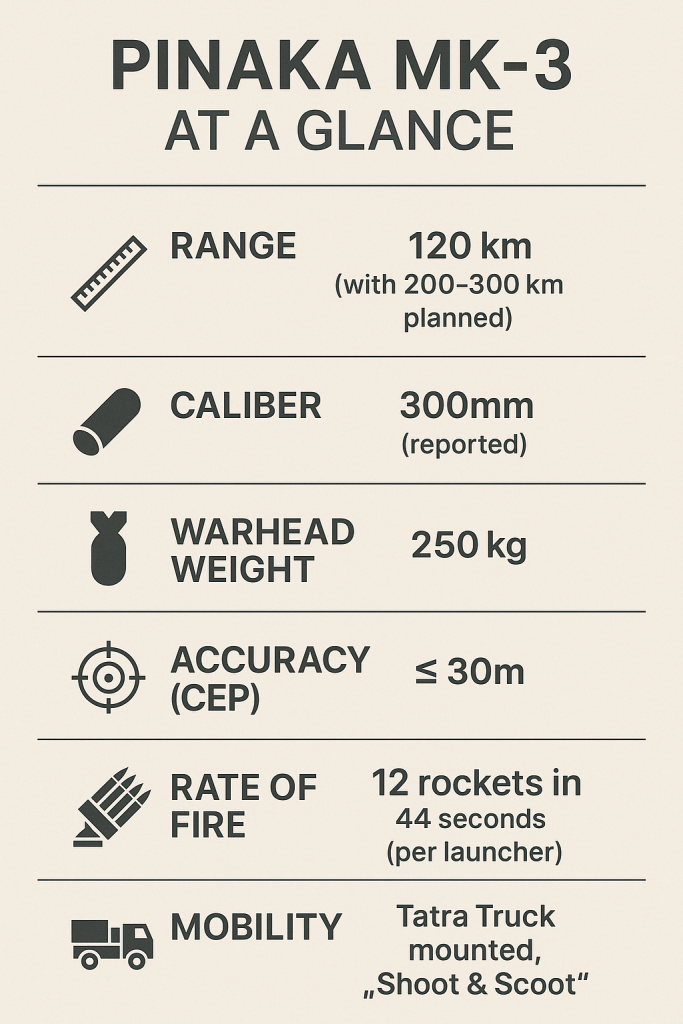
Vihar Vaishnav: This advanced system is a shining example of India’s “Aatmanirbhar Bharat” (self-reliant India) initiative, showcasing a robust domestic defense industry ready to meet the demands of modern warfare.
From Humble Beginnings to Battlefield Dominance
The journey of the Pinaka system began in the 1980s, with its development officially initiated in December 1986 by the Defence Research and Development Organisation (DRDO). The primary motivation was clear: to reduce India’s reliance on foreign military hardware, specifically to replace the Soviet-origin Russian “Grad” rocket system then in service with the Indian Army. This pursuit of an indigenous alternative was a crucial step towards achieving self-reliance in multi-barrel rocket systems.
By 1995, the Pinaka system had undergone successful testing. Its true capabilities were dramatically showcased during the Kargil War in 1999, where it played a pivotal role in effectively targeting enemy positions and disrupting strategies. This battlefield performance was instrumental in validating the system’s effectiveness and building confidence in India’s domestic defense capabilities. The positive operational feedback from Kargil was significant, leading to the formal induction of the first Pinaka regiment into the Indian Army in 2000.
Over the years, the Pinaka system has undergone a series of significant upgrades, reflecting a dynamic approach to continuous improvement. The initial Pinaka Mk-1 had a range of 40 km. Subsequent enhancements led to the Pinaka Mk-I Enhanced (45-60 km) , and the Pinaka Mk-II (60-90 km). A significant leap was the introduction of the Guided Pinaka, a precision-strike variant incorporating GPS-enabled guidance, boasting a range of 75-90 km and achieving remarkable accuracy with a Circular Error Probable (CEP) of less than 10-20 meters.
The Pinaka Mk-3: A New Era of Firepower
The Pinaka Mk-3 stands as the latest and most advanced iteration, designed to significantly augment the Indian Army’s firepower and strategic reach. Its core function remains to deliver lethal and responsive fire against a diverse array of targets, including enemy troops, vehicles, communication centers, and ammunition dumps. However, the Mk-3 is engineered to drastically improve the Indian Army’s strike range and power, thereby extending its operational reach considerably.
The first variant of the Pinaka Mk-3 is expected to achieve a range of 120 km or more. Looking further ahead, ambitious plans are underway for subsequent variants, including the Mk-3 ER (Extended Range) and LRGR (Long Range Guided Rocket), aiming for ranges of 200-300 km. The Indian Army formally approved the development of both 120 km and 300 km Pinaka variants in 2021, underscoring the urgency and strategic importance of these capabilities.
This increase in range is coupled with a substantial enhancement in payload capacity. The Pinaka Mk-3 is engineered to carry a larger 250 kg warhead, a significant increase from the typical 100 kg payload of earlier Pinaka variants. The system supports a versatile array of warhead types, including anti-tank mines, high explosives, high explosive fragmentation, cluster munition, incendiary, and anti-personnel munitions. The rockets are capable of reaching speeds of approximately 5757.70 km/h.

The 300mm Caliber Shift: A Game Changer
A critical engineering development for the Pinaka Mk-3 has been the reported shift to a larger caliber. While previous Pinaka variants primarily utilized a 214mm caliber rocket , the Pinaka Mk-3, as publicly unveiled at a defense exhibition in Hyderabad, exhibited a “visibly larger profile” suggesting a “300mm diameter”. This represents a substantial increase and is a direct tactical response to the larger calibers used by systems deployed by China and Pakistan.
The adoption of a 300mm caliber is crucial for achieving the stated 120 km range and for carrying the larger 250 kg warhead. This larger diameter allows for a significantly greater propellant load and accommodates more advanced guidance systems, aligning Pinaka Mk-3 with the performance characteristics of established international systems like Russia’s Smerch MBRL or China’s PHL-03. This caliber upgrade transforms Pinaka Mk-3 into a truly long-range artillery asset, capable of delivering heavier payloads over greater distances.
Precision and Digital Integration
A hallmark of the Pinaka Mk-3’s advanced capabilities is its sophisticated guidance system, which dramatically enhances its precision. The system features an improved guidance mechanism and integrates a sophisticated Guidance, Navigation, and Control (GNC) kit developed by DRDO’s Research Centre Imarat (RCI). This advanced GNC kit is crucial for enabling precision strikes, ensuring pinpoint accuracy even in challenging terrains such as the mountainous regions of Ladakh and Kargil. The Mk-3 builds upon the foundation established by the Guided Pinaka variant, which already incorporates an Inertial Navigation System (INS) and GPS for guidance. For the Mk-III, the accuracy is noted as ≤ 30m.
Beyond precision, the Pinaka Mk-3 offers significant operational flexibility. The launcher can operate in autonomous, stand-alone, remote, and manual modes, providing adaptability for various deployment scenarios.
Its interoperability with India’s digital battlefield architecture facilitates seamless coordination with surveillance drones, satellites, ground radars, and other reconnaissance assets. This real-time aggregation of data enables accurate, data-driven engagements, allowing the Indian Army to quickly detect, track, and eliminate high-value or time-critical targets.
A standard Pinaka battery typically comprises six launcher vehicles, each equipped with two pods carrying 12 rockets, alongside six loader-cum-replenishment vehicles, six additional replenishment vehicles, and two command post vehicles fitted with fire control computers. These launchers are mounted on highly mobile 8×8 Tatra truck chassis, providing essential mobility and stability during operations. This platform enables a crucial “shoot and scoot” capability, allowing the system to fire its salvo and quickly relocate to avoid counter-battery fire, thereby enhancing its survivability on the battlefield. A single Pinaka battery is designed to neutralize an area of approximately 700m x 500m or even 1,000m x 800m by unleashing a salvo of 72 rockets in just 44 seconds.
Development, Production, and Strategic Deployment
The Pinaka Mk-3 program is currently in an advanced stage, transitioning from development to operational readiness. DRDO’s Armament Research and Development Establishment (ARDE) leads this effort, collaborating with other key DRDO laboratories. Recent milestones include the public unveiling of the Pinaka Mk-III at a defense exhibition in Hyderabad. Trials for the 120-kilometer-range guided rocket system are set to commence imminently, uniquely combining both developmental and user trials to expedite induction into the Indian Army. The Guided Pinaka MLRS, a parallel advanced variant, successfully completed its flight tests on November 14, 2024, and is now ready for mass production.
The production of the Pinaka system is a testament to India’s commitment to building a robust domestic defense industrial base, aligning seamlessly with the “Aatmanirbhar Bharat” initiative.
This involves a comprehensive collaboration between DRDO and a network of both private and public sector entities. Rockets are manufactured by Economic Explosives Limited (EEL) and Munitions India Limited (MIL). Tata Advanced Systems Limited (TASL) and Larsen & Toubro (L&T) are responsible for producing launchers and Battery Command Posts. Indian industry players have established the capacity to produce over 5,000 rockets annually. The Indian government has already approved the procurement of 6,400 Pinaka rockets, valued at $337 million.

The Pinaka system is not merely a developmental project; it is an active and integral component of India’s immediate defense strategy. It is strategically deployed along India’s sensitive borders with both China and Pakistan. Its operational relevance has been particularly evident since May 2020, during which time it has been actively utilized amidst ongoing tensions along the Line of Actual Control (LAC) with China. The Indian Army currently operates four Pinaka regiments, with plans for additional regiments already in motion.
Global Standing and Export Potential
The development of the Pinaka Mk-3 is a direct response to the evolving geopolitical landscape and the capabilities of other major military powers. It is designed to achieve parity or superiority in artillery capabilities compared to systems deployed by China (e.g., A-100, PHL-03, WS-2) and Pakistan (e.g., Fatah-I, Fatah-II). The reported shift to a 300mm caliber for Mk-III is a direct tactical response to the larger calibers used by Chinese systems, indicating a deliberate strategy by India to ensure its indigenous systems are competitive.
While rapidly advancing, the Pinaka’s most advanced variants are still undergoing trials, whereas systems like the US HIMARS have had their advanced rockets in mass production for decades. However, the Pinaka Mk-3 offers a cost-effective alternative to imported systems like the Smerch MBRL.
India has historically been a major defense importer, but the success of indigenous programs like Pinaka is rapidly transforming its role in the global defense market.
The nation has now established itself as a credible defense exporter, with Indian systems being deployed in over 85 countries across Asia, Africa, the Middle East, Latin America, and beyond. The Pinaka rocket system is prominently featured among the high-end systems being exported. Concrete evidence of this shift includes the confirmed procurement of four Pinaka batteries and guided rockets by Armenia under a recent contract. Beyond confirmed sales, there is demonstrated international interest from various other nations, including Indonesia, Nigeria , and notably, France, with the French Army actively evaluating the Pinaka system.
Conclusion: A Symbol of Self-Reliance
The Pinaka Mk-3 Multi-Barrel Rocket Launcher system stands as a testament to India’s unwavering commitment to self-reliance and strategic autonomy in defense. Its development represents a significant advancement in the nation’s military technology, embodying a comprehensive approach to enhancing battlefield effectiveness through extended range, heightened precision, and multi-role capabilities. The ongoing development of 200-300 km variants, with the potential to elevate Pinaka into the short-range ballistic missile category, indicates an ambitious future trajectory aimed at achieving overmatch capabilities against evolving threats.
The Pinaka Mk-3 is not merely a weapon system; it is a symbol of India’s growing technological prowess and its strategic independence on the global stage, poised to redefine India’s defense posture and its role as a significant player in the international arms market.
![]()
